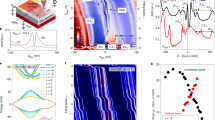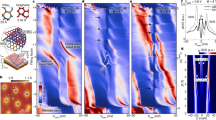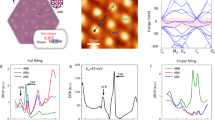Abstract
Magic-angle twisted trilayer graphene (MATTG) hosts flat electronic bands, and exhibits correlated quantum phases with electrical tunability. In this work, we demonstrate a spectroscopy technique that allows for dissociation of intertwined bands and quantification of the energy gaps and Chern numbers C of the correlated states in MATTG by driving band crossings between Dirac cone Landau levels and energy gaps in the flat bands. We uncover hard correlated gaps with C = 0 at integer moiré unit cell fillings of ν = 2 and 3 and reveal charge density wave states originating from van Hove singularities at fractional fillings ν = 5/3 and 11/3. In addition, we demonstrate displacement-field-driven first-order phase transitions at charge neutrality and ν = 2, which are consistent with a theoretical strong-coupling analysis, implying C2T symmetry breaking. Overall, these properties establish a diverse electrically tunable phase diagram of MATTG and provide an avenue for investigating other related systems hosting both steep and flat bands.
This is a preview of subscription content, access via your institution
Access options
Access Nature and 54 other Nature Portfolio journals
Get Nature+, our best-value online-access subscription
$29.99 / 30 days
cancel any time
Subscribe to this journal
Receive 12 print issues and online access
$259.00 per year
only $21.58 per issue
Buy this article
- Purchase on Springer Link
- Instant access to full article PDF
Prices may be subject to local taxes which are calculated during checkout




Similar content being viewed by others
Data availability
Source data for the main figures and the Extended Data figures are provided along with this paper. Other supporting data are available from the corresponding author upon reasonable request. Source data are provided with this paper.
References
Cao, Y. et al. Correlated insulator behaviour at half-filling in magic-angle graphene superlattices. Nature 556, 80–84 (2018).
Tang, Y. et al. Simulation of Hubbard model physics in WSe2/WS2 moiré superlattices. Nature 579, 353–358 (2020).
Shen, C. et al. Correlated states in twisted double bilayer graphene. Nat. Phys. 16, 520–525 (2020).
Regan, E. C. et al. Mott and generalized Wigner crystal states in WSe2/WS2 moiré superlattices. Nature 579, 359–363 (2020).
Cao, Y. et al. Tunable correlated states and spin-polarized phases in twisted bilayer–bilayer graphene. Nature 583, 215–220 (2020).
Liu, X. et al. Tunable spin-polarized correlated states in twisted double bilayer graphene. Nature 583, 221–225 (2020).
Chen, S. et al. Electrically tunable correlated and topological states in twisted monolayer–bilayer graphene. Nat. Phys. 17, 374–380 (2021).
Chen, G. et al. Evidence of a gate-tunable Mott insulator in a trilayer graphene moiré superlattice. Nat. Phys. 15, 237–241 (2019).
Polshyn, H. et al. Electrical switching of magnetic order in an orbital Chern insulator. Nature 588, 66–70 (2020).
Cao, Y. et al. Unconventional superconductivity in magic-angle graphene superlattices. Nature 556, 43–50 (2018).
Yankowitz, M. et al. Tuning superconductivity in twisted bilayer graphene. Science 363, 1059–1064 (2019).
Lu, X. et al. Superconductors, orbital magnets and correlated states in magic-angle bilayer graphene. Nature 574, 653–657 (2019).
Sharpe, A. L. et al. Emergent ferromagnetism near three-quarters filling in twisted bilayer graphene. Science (1979) 365, 605–608 (2019).
Nuckolls, K. P. et al. Strongly correlated Chern insulators in magic-angle twisted bilayer graphene. Nature 588, 610–615 (2020).
Chen, G. et al. Tunable correlated Chern insulator and ferromagnetism in a moiré superlattice. Nature 579, 56–61 (2020).
Serlin, M. et al. Intrinsic quantized anomalous Hall effect in a moiré heterostructure. Science 367, 900 (2020).
Das, I. et al. Symmetry-broken Chern insulators and Rashba-like Landau-level crossings in magic-angle bilayer graphene. Nat. Phys. 17, 710–714 (2021).
Saito, Y. et al. Hofstadter subband ferromagnetism and symmetry-broken Chern insulators in twisted bilayer graphene. Nat. Phys. 17, 478–481 (2021).
Wu, S., Zhang, Z., Watanabe, K., Taniguchi, T. & Andrei, E. Y. Chern insulators, van Hove singularities and topological flat bands in magic-angle twisted bilayer graphene. Nat. Mater. 20, 488–494 (2021).
Park, J. M., Cao, Y., Watanabe, K., Taniguchi, T. & Jarillo-Herrero, P. Flavour Hund’s coupling, Chern gaps and charge diffusivity in moiré graphene. Nature 592, 43–48 (2021).
Choi, Y. et al. Correlation-driven topological phases in magic-angle twisted bilayer graphene. Nature 589, 536–541 (2021).
Park, J. M., Cao, Y., Watanabe, K., Taniguchi, T. & Jarillo-Herrero, P. Tunable strongly coupled superconductivity in magic-angle twisted trilayer graphene. Nature 590, 249–255 (2021).
Hao, Z. et al. Electric field–tunable superconductivity in alternating-twist magic-angle trilayer graphene. Science 371, 1133–1138 (2021).
Cao, Y., Park, J. M., Watanabe, K., Taniguchi, T. & Jarillo-Herrero, P. Pauli-limit violation and re-entrant superconductivity in moiré graphene. Nature 595, 526–531 (2021).
Novoselov, K. S. et al. Two-dimensional gas of massless Dirac fermions in graphene. Nature 438, 197–200 (2005).
Zhang, Y., Tan, Y.-W., Stormer, H. L. & Kim, P. Experimental observation of the quantum Hall effect and Berry’s phase in graphene. Nature 438, 201–204 (2005).
Pierce, A. T. et al. Unconventional sequence of correlated Chern insulators in magic-angle twisted bilayer graphene. Nat. Phys. 17, 1210–1215 (2021).
Kwan, Y. H. et al. Kekulé spiral order at all nonzero integer fillings in twisted bilayer graphene. Phys. Rev. X 11, 41063 (2021).
Kim, H. et al. Evidence for unconventional superconductivity in twisted trilayer graphene. Nature 606, 494–500 (2022).
Khalaf, E., Kruchkov, A. J., Tarnopolsky, G. & Vishwanath, A. Magic angle hierarchy in twisted graphene multilayers. Phys. Rev. B 100, 85109 (2019).
Carr, S. et al. Ultraheavy and ultrarelativistic Dirac quasiparticles in sandwiched graphenes. Nano Lett. 20, 3030–3038 (2020).
Lei, C., Linhart, L., Qin, W., Libisch, F. & MacDonald, A. H. Mirror symmetry breaking and lateral stacking shifts in twisted trilayer graphene. Phys. Rev. B 104, 35139 (2021).
Li, X., Wu, F. & MacDonald, A. H. Electronic structure of single-twist trilayer graphene. Preprint at https://arxiv.org/abs/1907.12338 (2019).
Khalaf, E., Chatterjee, S., Bultinck, N., Zaletel, M. P. & Vishwanath, A. Charged skyrmions and topological origin of superconductivity in magic-angle graphene. Sci. Adv. 7, 5299 (2021).
Xie, F., Regnault, N., Călugăru, D., Bernevig, B. A. & Lian, B. Twisted symmetric trilayer graphene. II. Projected Hartree–Fock study. Phys. Rev. B 104, 115167 (2021).
Christos, M., Sachdev, S. & Scheurer, M. S. Correlated insulators, semimetals, and superconductivity in twisted trilayer graphene. Phys. Rev. X 12, 021018 (2022).
Ledwith, P. J. et al. TB or not TB? Contrasting properties of twisted bilayer graphene and the alternating twist n-layer structures (n = 3, 4, 5,…). Preprint at https://arxiv.org/abs/2111.11060 (2021).
Lin, J.-X. et al. Spin-orbit–driven ferromagnetism at half moiré filling in magic-angle twisted bilayer graphene. Science 375, eabh2889 (2022).
Huang, C., Wei, N., Qin, W. & MacDonald, A. Pseudospin paramagnons and the superconducting dome in magic angle twisted bilayer graphene. Preprint at https://arxiv.org/abs/2110.13351 (2021).
Park, J. M. et al. Robust superconductivity in magic-angle multilayer graphene family. Nat. Mater. 21, 877–883 (2022).
Zhang, Y. et al. Promotion of superconductivity in magic-angle graphene multilayers. Science (1979) 377, 1538–1543 (2022).
Acknowledgements
We thank B. Andrei Bernevig, L. Xian and Q. Wu for fruitful discussions and I. Das, A. Jaoui, C.-W. Cho and B.A. Piot for the help with cryogenic measurements. P.J.L. acknowledges fruitful discussions with M. Christos and support by the Department of Defense (DoD) through the National Defense Science and Engineering Graduate Fellowship (NDSEG) Program. E.K. was supported by the German National Academy of Sciences Leopoldina through grant number LPDS 2018-02. A.V. was supported by a Simons Investigator award and by the Simons Collaboration on Ultra-Quantum Matter, which is a grant from the Simons Foundation (grant number 651440). D.K.E. acknowledges support from the Ministry of Economy and Competitiveness of Spain through the ‘Severo Ochoa’ programme for Centres of Excellence in R&D (SE5-0522), Fundació Privada Cellex, Fundació Privada Mir-Puig, the Generalitat de Catalunya through the CERCA programme, funding from the European Research Council (ERC) under the European Union’s Horizon 2020 research and innovation programme (grant agreement number 852927). K.W. and T.T. acknowledge support from the Elemental Strategy Initiative conducted by the MEXT, Japan (grant number JPMXP0112101001) and JSPS KAKENHI (grant numbers 19H05790, 20H00354 and 21H05233).
Author information
Authors and Affiliations
Contributions
C.S. and D.K.E. conceived of the project. C.S. fabricated devices, performed transport measurements and analysed the experimental data. P.J.L, E.K. and A.V. performed the numeric simulations. K.W. and T.T. provided the hBN crystals. C.S., P.J.L., E.K., A.V. and D.K.E. discussed the data. C.S., P.J.L., E.K., A.V. and D.K.E. wrote the paper.
Corresponding authors
Ethics declarations
Competing interests
The authors declare no competing interests.
Peer review
Peer review information
Nature Materials thanks Oleg Yazyev and the other, anonymous, reviewer(s) for their contribution to the peer review of this work.
Additional information
Publisher’s note Springer Nature remains neutral with regard to jurisdictional claims in published maps and institutional affiliations.
Extended data
Extended Data Fig. 1 Landau fan diagram and Landau level crossing at D=0V/nm.
a, b, Landau fan diagram shown by longitudinal resistance Rxx and transverse Hall resistance Rxy. c, schematic of Landau level structure as observed in panel (a) and panel (b).
Extended Data Fig. 2 Phase diagram in perpendicular magnetic field and chemical potential measurement at D=0V/nm.
a, four types of phases in perpendicular magnetic field when Dirac cone coexists with moiré flat band. The dash lines denote phase boundaries. Phases II and III correspond to partially filling Nth D-LL, which shows finite band broadening due to disorder effects. The phase boundary between phase II and III, namely AN and BN is marked with solid line. In illustration schematics for each phase, the emergent correlated gap is shown by flat band splitting. b, chemical potential measurement at D = 0V/nm. The dark cyan dots show energy difference between flat band and Dirac cone vertex, which is obtained via phase III with D-LL index N = 1. The yellow dash line denotes a tentative plotting of Dirac cone shifting as a function of charge filling, where the zero energy corresponds to energy of flat band charge neutrality.
Extended Data Fig. 3 Zoom-in Landau fan diagram around v=2 at moderate displacement field.
The top, middle and bottom panels are mapping plots of longitudinal resistance Rxx of two neighbour regions R1 and R2 and Hall resistance Rxy, respectively. From the left to the right panel, displacement field D is D = 0,0.05,0.1,0.15 and 0.2V/nm in sequence.
Supplementary information
Supplementary Information
Supplementary Figs. 1–11 and Discussion.
Source data
Source Data Fig. 1
Statistical source data
Source Data Fig. 2
Statistical source data
Source Data Fig. 3
Statistical source data
Source Data Fig. 4
Statistical source data
Source Data Extended Data Fig. 1
Statistical source data
Source Data Extended Data Fig. 2
Statistical source data
Source Data Extended Data Fig. 3
Statistical source data
Rights and permissions
Springer Nature or its licensor (e.g. a society or other partner) holds exclusive rights to this article under a publishing agreement with the author(s) or other rightsholder(s); author self-archiving of the accepted manuscript version of this article is solely governed by the terms of such publishing agreement and applicable law.
About this article
Cite this article
Shen, C., Ledwith, P.J., Watanabe, K. et al. Dirac spectroscopy of strongly correlated phases in twisted trilayer graphene. Nat. Mater. 22, 316–321 (2023). https://doi.org/10.1038/s41563-022-01428-6
Received:
Accepted:
Published:
Issue Date:
DOI: https://doi.org/10.1038/s41563-022-01428-6
This article is cited by
-
Functional nanoporous graphene superlattice
Nature Communications (2024)
-
Unravelling the magic of twisted trilayer graphene
Nature Materials (2023)



